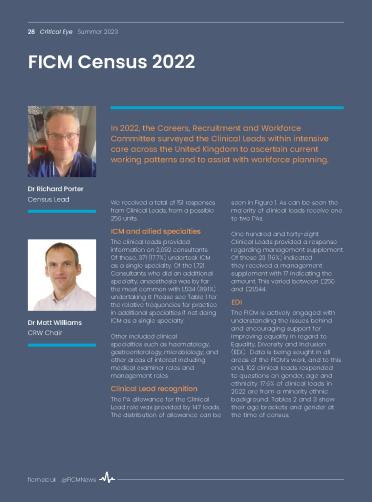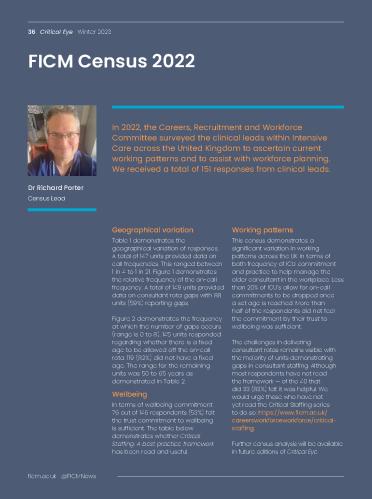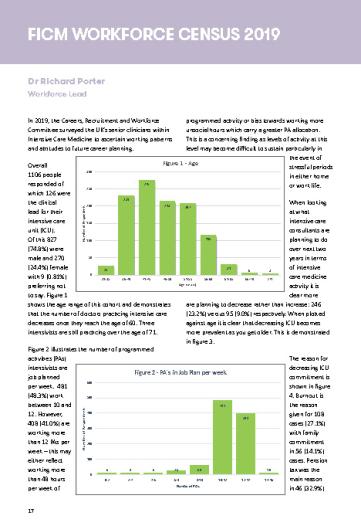Census
2023 Census Information
The 2023 Workforce Census will primarily focus on the consultant workforce.
Email invitations to complete the census were sent to all the Clinical Directors and Clinical Leads we have on record in September 2023.
The deadline to submit data for the Census is Friday 20 October 2023.
If you are the Clinical Director or Clinical Lead for an Intensive Care Unit and do not get an email invitation to complete the census it may be because: you might have opted out of receiving communications from SurveyMonkey, or it has gone into your spam/junk mail folder; or the email address we have on file for you is out of date or we do not currently have you as a Clinical Lead in our records, please contact us so we can look into this for you.
Data collection
We would encourage all ICM consultants to assist the Faculty in every way they can to ensure this simple and short survey is completed during its annual collection phase (usually March to June).
It is essential the Faculty receives a high responses rate so that we can build a robust dataset upon which to base projections. The results of this exercise will be employed by the Faculty to:
- Illustrate to external bodies the need for our skillset and services within and beyond the ICU, both now and in the future healthcare environment.
- Facilitate workforce planning. The Faculty is already fully engaged with the Centre for Workforce Intelligence, that has been charged by the DoH to undertake a ‘deep dive’ on the need for consultants in intensive care medicine now and out to the mid 2030s. This exercise can be effective only when informed by the information we now seek from the Fellowship.
- Inform our discussions with Health Education England concerning the numbers of trainees needed for our specialty, and the manner in which they should be recruited, now and over the next decade.
- Enable us to respond to the Shape of Training Review which has made strong recommendations, likely to be adopted by central government, regarding the skillset and competencies needed by the future consultant/trained medical workforce.
2022 Census - 10 Key Points
- 151 responses received from the 264 Clinical Leads contacted
- Of the 101 respondents to this question - 32 (32%) Clinical Leads identified as female, and 83 (82%) as white ethnic origin
- Out of 2092 consultants, 371 (17.7%) clinical practice is for ICU as a single specialty
- 1534 of the 1721 (89.1%) who practiced more than one specialty undertook anaesthesia as a second specialty
- 77% of Clinical Leads received 1 to 2 PA’s for this role
- Duty consultant On-call frequency was between 1 in 4 to 1 in 24. Most common frequency: 1 in 8
- Consultant vacancies (rota gaps) were present in 88 (59%) of responding units – reporting 1 to 8 gaps.
- No set age to come off the rota was noted in 119 of the units (82%)
- FICM’s Critical Staffing document series was considered useful by 33 of the respondents (26%) – with further 65 (51%) were planning on reading the articles
- Improving staffing levels was seen as the most significant intervention that could positively address wellbeing by 65 (59%) of the 110 respondents to this question
Past Census Overviews
Workforce in Intensive Care Medicine
Recruitment to Retirement - A Census update for Fellows and Members
FICM Workforce Advisory Group Position Statement
The Workforce Advisory Group has published a position paper based on the 2014 Workforce Census and the information collected for the CfWI report. The paper:
- Describes the current physical and human resources available for the delivery for the intensive care to patients in England and Wales
- Attempts to predict future demand for the clinical service and records the best estimates that can be made of the current and future composition (up to 2035) of the medical workforce
- Makes recommendations as how to how this data should be employed.
The position paper and accompanying covering letter can be read below:



